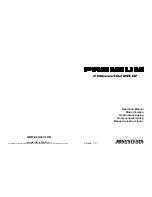
LFS4100
Chapter 8: Fiber Holder Insert Selection Guide
Page 36
TTN047498-D01
Fiber Holder Bottom Inserts for larger cladding or buffer diameters (indicated with Item #'s starting with VHE)
come in single-sided and double-sided versions; the specified fiber diameter (in µm) is engraved on the part.
These bottom inserts can also be used in the FPS300 Fiber Preparation Station, LDC Series of Fiber Cleavers,
and GPX Glass Processing Systems. Positional reference of the fibers will not be maintained when these inserts
are transferred between systems
.
Fiber Holder Insert
Side 1 Accepted Diameter
(Min / Max)
Side 2 Accepted Diameter
(Min / Max)
VHE10
773 µm / 1271 µm
1034 µm / 1523 µm
VHE15
1280 µm / 1769 µm
1534 µm / 2007 µm
VHE20
1787 µm / 2267 µm
2033 µm / 2513 µm
VHE25
2270 µm / 2844 µm
N/A
VHE30
2692 µm / 3198 µm
N/A
The table below indicates the minimum and maximum diameters that can be accommodated by different
combinations of top and bottom inserts. It also indicates how far offset the fiber will be for recommended
combinations of top and bottom inserts. Note that this outer diameter may be the fiber cladding, jacket, or buffer. If
one side of the fiber is being discarded, it is preferable to clamp onto the cladding of this section except in special
cases (such as non-circular fiber) where the coating or buffer may be preferable. Sections of fiber that are not
being discarded should always be clamped on the coating or buffer in order to avoid damaging the glass. This
may require different sets of fiber holder inserts to be used in the left and right holding blocks. In this case, it is
important to minimize the difference in the offsets introduced by the left and right sets of inserts when attempting
to produce high quality splices.
1. First, select the bottom insert that matches your fiber size most closely.
Example:
For an Ø800 µm fiber, the VHF750 insert is the closest match, since it is only 50 µm smaller.
2. On the chart below, look to the right of your chosen bottom insert. Select a compatible top insert
based on the fiber diameter size range shown in each cell. Green cells indicate the best fit, orange
cells indicate the second best fit, and white cells indicate the third best fit.
Example:
For the Ø800 µm example fiber from step 1, the green cell is in the 750 µm groove column for
the VHA05 and VHB05 top inserts, which have two grooves. The numbers listed in the green cell indicate
that this combination of inserts is good for fibers from 728 to 963 µm in diameter. Our Ø800 µm fiber is
within this range, so this is a good choice. There are several other options that will accommodate an
Ø800 µm fiber as well, but the green shading in the chart indicates that the 750 µm groove in either the
VHA05 of VHB05 provides the best fit. Of these two top insert options, the VHB05 is compatible with end-
view imaging but the VHA05 is not.
3. The second line of numbers in each cell shows the range of offsets that can be expected for any
given combination of top and bottom inserts. When selecting inserts for the right and left fiber
holding blocks, try to minimize the offsets between the pairs of inserts on each side.
Example:
If we choose a VHF750 bottom insert and the Ø750 µm groove in the VHA05 top insert, we
can use fiber as small as 728 µm, in which case the center of the fiber would sit 23 µm below the surface
of the bottom insert. We could also clamp a fiber as large as 963 µm, in which case the center of the fiber
would sit 213 µm above the surface of the bottom insert. We could interpolate to find the offset expected
for our hypothetical 800 µm fiber, but it turns out that in a 60° V-groove, the offset is equal to the diameter
difference. So, that means that the center of our fiber is going to sit 50 µm above the bottom insert
surface because it is 50 µm larger than the fiber that the bottom insert was designed for (800 - 750 = 50).
4. Holding blocks designed for fibers less than 1000 µm in diameter have vacuum holes, designed to
aid in aligning small fiber within the groove, while bottom inserts for fibers of Ø1000 µm or larger
do not have these holes.
The LFS4100 has a vacuum pump that provides a small holding force via these holes, keeping small
fibers in place as the clamps are lowered.
Summary of Contents for Vytran LFS4100
Page 1: ...LFS4100 Fiber Splicer User Guide...
Page 44: ...www thorlabs com...






































